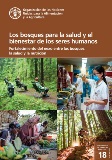Inseparable link between forests and human health

©FAO/Noel Celis
There is growing recognition of the importance of forests for food security and nutrition but not enough attention on the essential role which forests play in human health, experts of the Food and Agriculture Organization of the United Nations (FAO) said as the agency released a new publication on forests and human well-being.
The 84-page publication, “Forests for human health and well-being,” is designed to expand the range of practitioners, policymakers and Others who are involved in better understanding and sustainably managing forests and their broad contributions to human health and well-being – including nutrition, medicines and environmental benefits.
The publication contains a broad overview of the many ways in which forests touch our lives and a series of recommendations for people and institutions in a range of fields, including forestry, food security and nutrition, health, land use, and urban planning.
“It will take communities, governments, organizations and citizens and experts from all walks of life to sustainably manage our forests and understand how they work because they provide benefits and services in so many areas, including our health, nutrition, livelihoods and well-being,” said FAO Forestry Division Director, Mette Wilkie.
The publication points out that from 25-80 percent of commercial pharmaceutical products, including drugs used for the prevention of malaria, treatment of cancer, diabetes, and prostate conditions, are plant based–some of whichare now synthesized, but up to 60 percent are still collected from the wild.
It also lists other ways in which forests are a fundamental part of people’s daily lives, whether in rural or urban areas. For example, a study of 22 countries in Asia and Africa found that indigenous communities use an average of 120 wild foods per community. In Europe, a survey of over 17 000 households in 28 European countries showed that almost 92 percent had consumed wild forest products (game, mushrooms, edible plants).
Authors call for promotion of a One Health approach to bring together professionals and policymakers in forestry, natural resources, agriculture, livestock, public health and nutrition to better observe and develop solutions which take into account the meeting points between human and animal lives and their various environments.
A cornerstone of this approach is cross-sectoral collaboration to gather more data on the contributions of forests and forest-dwelling communities to human health and well-being according to the context, distinguishing between populations living in or near forests, and populations more distant from forests (particularly urban populations).
Related publication

